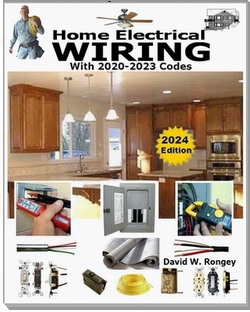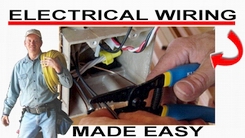» Residential Wiring Codes
» Need Electrical Help? Ask the Electrician
National Electric Codes for Wire in Electrical Boxes NEC-Table370-16a

|
Summary: The National Electrical Code explains the Maximum Number of Wires that can be installed into a box, otherwise known as Box Fill. This code is based upon the type of box, wires, wire sizes, wire clamps and conduit fittings. Adjustments are made for the ground wire as you will see in the table below.
© By: Dave Rongey |
Calculating The Minimum Size Junction Box for Electrical Wiring
Wire in Electrical Box - Box Fill Calculations
Part (1) of Section 370-16(a) describes in detail the method of counting wires, as well as clamps, fittings, or devices (i.e., switches, receptacles, combination devices) - by establishing an equivalent conductor-value for each.
These values are added together to get a total number of conductors.
The minimum size box is the smallest one in the Box Fill Table (shown) that can accommodate that number of conductors.
| BOX FILL TABLE |
| Volume Required per Conductor Size per Deductions |
| DEDUCTIONS | |||||||||
| 6 | 7 | 8 | 9 | 10 | 11 | 12 | 13 | 14 | |
| #18 (1.50) |
9.00 | 10.50 | 12.00 | 13.50 | 15.00 | 16.50 | 18.00 | 19.50 | 21.00 |
| #16 (1.75) |
10.50 | 12.25 | 14.00 | 15.75 | 17.50 | 19.25 | 21.00 | 22.75 | 24.50 |
| #14 (2.00) |
12.00 | 14.00 | 16.00 | 18.00 | 20.00 | 22.00 | 24.00 | 26.00 | 28.00 |
| #12 (2.25) |
13.50 | 15.75 |
18.00 | 20.25 | 22.50 | 24.75 | 27.00 | 29.25 | 31.50 |
| #10 (2.50) |
15.00 | 17.50 | 20.00 | 22.50 | 25.00 | 27.50 | 30.00 | 32.50 | 35.00 |
| #8 (3.00) |
18.00 | 21.00 | 24.00 | 27.00 | 30.00 | 33.00 | 36.00 | 39.00 | 42.00 |
| #6 (5.00) |
30.00 | 35.00 | 40.00 | 45.00 | 50.00 | 55.00 | 60.00 | 65.00 | 70.00 |
How to Prevent Electrical Box Over Fill By Using this Table and Information
Points to Remember:
- No matter how many ground wires come into a box, they only count as one conductor within the box.
- Any wire running unbroken through the box counts as one wire.
- Each wire coming into a splice device (crimp or twist-on type) is counted as one wire.
- Each wire coming into the box and connecting to a device counts as one wire of that size.
- Where devices are mounted in the box, the total conductor count must be increased by two for each mounting strap because the strap takes up space.
Electrical Box Wire Fill Table
NEC Table 370-16(a) Metal Boxes |
||||||||
|
Number of Conductors in Outlet, Device, |
||||||||
Box |
Min- |
Maximum Number of Conductors |
||||||
No. 18 |
No. 16 |
No. 14 |
No. 12 |
No. 10 |
No. 8 |
No. 6 |
||
round or octagonal 4"X |
12.5 |
8 |
7 |
6 |
5 |
5 |
4 |
2 |
square 4"X |
18.0 |
12 |
10 |
9 |
8 |
7 |
6 |
3 |
square 4"-11/16X |
25.5 |
17 |
14 |
12 |
11 |
10 |
8 |
5 |
device 3"X |
7.5 |
5 |
4 |
3 |
3 |
3 |
2 |
1 |
device 4"X |
10.3 |
6 |
5 |
5 |
4 |
4 |
3 |
2 |
masonry box / gang 3 3/4'
X |
14.0 21.0 |
9 14 |
8 12 |
7 10 |
6 9 |
5 8 |
4 7 |
2 4 |
The Safest Way to Test Electrical Devices and Identify Electric Wires!The Non-Contact Electrical TesterThis is a testing tool that I have had in my personal electrical tool pouch for years, and is the first test tool I grab to help identify electrical wiring. It is a Non-contact tester that I use to easily Detect Voltage in Cables, Cords, Circuit Breakers, Lighting Fixtures, Switches, Outlets and Wires. Simply insert the end of the tester into an outlet, lamp socket, or hold the end of the tester against the wire you wish to test. Very handy and easy to use.
The Quickest Way to Check for Faulty Electrical Wiring!The Plug-In Outlet TesterThis is the first tool I grab to troubleshoot a problem with outlet circuit wiring. This popular tester is also used by most inspectors to test for power and check the polarity of circuit wiring. It detects probable improper wiring conditions in standard 110-125 VAC outlets Provides 6 probable wiring conditions that are quick and easy to read for ultimate efficiency Lights indicate if wiring is correct and indicator light chart is included Tests standard 3-wire outlets UL Listed Light indicates if wiring is incorrect Very handy and easy to use.
Strip Off Wire Insulation without Nicking and Damaging the Electric Wire!The Wire Stripper and Wire CutterMy absolute favorite wire stripping tool that I have had in my personal electrical tool pouch for years, and this is the tool I use to safely strip electrical wires. This handy tool has multiple uses: The wire gauges are shown on the side of the tool so you know which slot to use for stripping insulation. The end of the tool can be used to grip and bend wire which is handy for attaching wire onto the screw terminals of switches and outlets.. The wire stripper will work on both solid and stranded wire. This tool is Very Handy and Easy to Use. |
||
Residential Electrical Parts and AccessoriesLight Switches 120volt Outlets Circuit Breakers Electrician Tools Voltage Testers |















